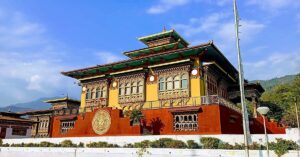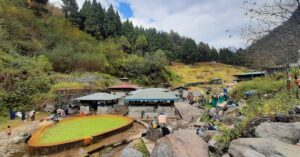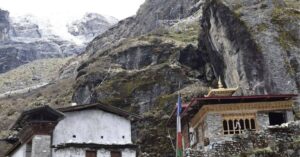Druk Wangyal Chortens, also known as Druk Wangyal Khang Zang Chortens or simply Dochula Chortens, are 108 memorial stupas on the Dochula Pass. Dochula Chortens were built by the eldest Queen Mother, Ashi Dorji Wangmo Wangchuck, in 2003. It was built to commemorate Bhutan’s victory led by His Majesty the Great Fourth and in honor of the soldiers who lost their lives in a military operation against insurgents in 2003.
Dochu La is a mountain pass located on the road between Thimphu and Punakha at an altitude of 3,150 meters (10,330 feet). The Dochula Pass has become one of the most visited places in Bhutan after the construction of the Druk Wangyal Complex in 2004.
The Druk Wangyal Complex has four significant monuments: the 108 Druk Wangyal Chortens, Druk Wangyal Lhakhang, the annual Druk Wangyal Festival, and the Sixtieth Anniversary Park, which honors the Fourth King Jigme Singye Wangchuck.
How To Reach Druk Wangyal Chortens at Dochula Pass
Druk Wangyal Chortens at Dochula Pass are located 22 kilometers from Thimphu on the way to Punakha. It takes 45 minutes by car via Simtokha Dzong Viewpoint. No entry fee is required to visit Druk Wangyal Chortens in Dochula Pass.
What to See at Dochula Druk Wangyel Complex
- 108 Dochula memorial Stupas;
- Druk Wangyal Lhakhang;
- Sixtieth Anniversary Park;
- Druk Wangyal Festival.
Dochula Pass
Dochula Pass is a popular mountain Pass in Bhutan, connecting Thimphu and Punakha at a height of 3,150 meters. In Dzongkha, Dochu La translates to “the Pass of Rock and Water.” The words Do and Chu mean rock and water, respectively, and La means Pass.
With the weather being mostly foggy and cold, the temperature at Dochula Pass usually remains below 5 degrees Celsius. But when it’s clear, you can see the panoramic view of Bhutan’s mountain range. Don’t miss the Mt. Gangkar Puensum, Bhutan’s highest mountain peak and the world’s tallest unclimbed mountain, at 7,570 meters and a prominence of 2,995 meters.
Enjoy your favorite coffee and desserts at the Druk Wangyal Cafeteria before traveling to explore Punakha Dzong and other tourist spots.
History of Druk Chortens at Dochula Pass
When India launched Operations against Assam separatist groups in 1990, Assamese insurgents moved their camps to Bhutan. The Royal Government of Bhutan learnt about the hideouts of militants along its southern border by 1996. As a result, in 1998, they first sought peaceful negotiations with the militant forces.
However, the insurgents refused to leave Bhutanese territory. With several rounds of unsuccessful talks over the years, the Bhutanese government issued a two-day ultimatum on December 13, 2003, to leave Bhutan. After two days, Operation All Clear was launched against the militants led by His Majesty the Great Fourth.
During the operation, the Bhutanese army successfully dislodged the rebels from their 30 camps in Bhutanese land. To commemorate Bhutan’s victory led by His Majesty the Great Fourth and to honor the Bhutanese soldiers who sacrificed their precious lives in the battle, Ashi Dorji Wangmo Wangchuck, the eldest Queen Mother, built 108 Druk Wangyal Chortens.
Significance of Druk Wangyal Chortens
The 108 Dochula Pass Memorial Chortens were built to commemorate Bhutan’s victory in the military operation against foreign militants who had settled along Bhutan’s southern borders and in memory of the Bhutanese army who sacrificed their lives for the country. It serves as a memorial and reminder of the sacrifices made by His Majesty the King Jigme Singye Wangchuck and the Bhutanese soldiers.
Description of Druk Wangyal Khang Zhang Chortens
The victory stupas, Druk Wangyal Chortens, were built at Dochula Pass by the end of 2003 and completed in June 2004. They are arranged in three layers built around the main Khang Zang Chorten. The first at the base of a hill has 45 chortens, the second level has 36, and the top layer has 27 stupas. All the Druk Wangyal Chortens are white with a red band in the middle and yellow pinnacles. There are other stupas at the Dochula Pass.
Sixtieth Anniversary Park
The Sixtieth Anniversary Park, located above the Druk Wangyel Chortens, was developed by Her Majesty the Queen Mother. It was designed to commemorate the 60th Birth Anniversary of His Majesty the Fourth King Jigme Singye Wangchuck in 2015.
This spiritual park has eleven meditation caves, each dedicated to the Buddha, Chana Dorji, Drukpa Kunley, Tsheringma, Guru Rinpoche, Zhabdrung Ngawang Namgyel, Milarepa, White Tara, Chenrizig, Yudenma, and Jampelyang.
The park also has a symbolic 16-step path representing the age at which His Majesty became King, which leads to an imposing cypress tree encircled by a wheel with 34 spokes, signifying the Great Fourth’s 34 golden years.
Best Time to Visit Druk Wangyal Chortens in Dochula Pass
The Dochula Pass remains beautiful in all seasons. The spring (March-May) and autumn (September-November) seasons are the best times to visit the Dochula stupas at Dochula Pass. However, we suggest you visit Dochula on 13 December to participate in the Druk Wangyal Tshechu festival. You can visit the major pilgrimage sites of Thimphu with the Bhutan Pilgrimage Package.
Conclusion
The Druk Wangyal Chortens at Dochula Pass are a memorial site dedicated to the victory of the Bhutanese army led by the Fourth King, as well as in memory of the soldiers who sacrificed their lives in the fight against Assamese militants in 2003. Druk Wangyal Complex at Dochula Pass, with its 108 memorial chortens and the Druk Wangyal Lhakhang, has become one of the most popular tourist destinations in Bhutan since 2004. From Dochula Pass, you can hike down to the Lampelri Royal Botanical Garden or up to the Lungchutse Goemba.
Other Sacred Sites to Explore in Thimphu
Buddha Dordenma: It is a massive golden statue of Buddha Shakyamuni overlooking the Thimphu valley. The site also houses thousands of smaller Buddha statues and a meditation hall.
National Memorial Chorten: Thimphu Chorten is a stupa built in memory of the third king, Jigme Dorji Wangchuck, in 1974.
Tashichho Dzong: It is a fortress that houses the king’s throne room, government offices, and the central monastic body. Known as the “Fortress of the Glorious Religion,” it blends religious and administrative functions with stunning Bhutanese architecture.
Pangri Zampa Monastery: It is one of Bhutan’s oldest monasteries, founded in the 16th century by Ngawang Chogyal. The monastery now functions as Bhutan’s Royal College of Astrology, responsible for determining dates for important national events.
Cheri Monastery: It is the first monastery established in Bhutan by Zhabdrung Ngawang Namgyel in 1620.
Tango Monastery: The Tango Choying Dzong was founded in the 13th century by Phajo Drugom Zhigpo. The monastery is perched on a forested hillside near Cheri Mountain.
Enjoyed reading this blog?




